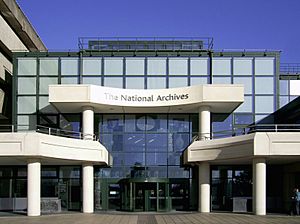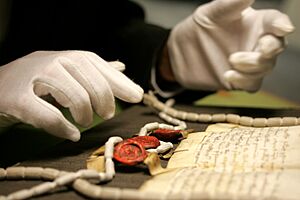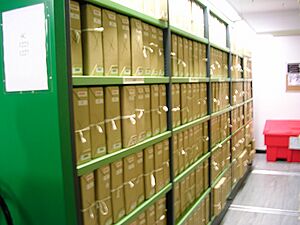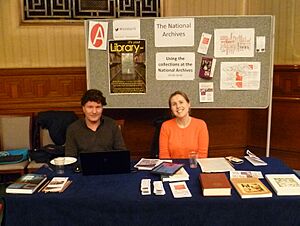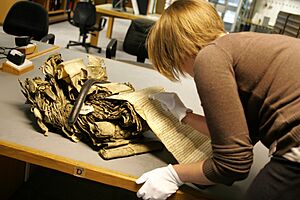The National Archives (United Kingdom) facts for kids
 |
|
| Non-ministerial department overview | |
|---|---|
| Formed | April 2003 |
| Jurisdiction | England and Wales, HM Government |
| Headquarters | Kew, Richmond 51°28′52″N 0°16′46″W / 51.48111°N 0.27944°W |
| Employees | 582 |
| Annual budget | |
| Ministers responsible |
|
| Non-ministerial department executive |
|
| Parent department | Department for Culture, Media and Sport |
| Child agencies |
|
| Key document |
|
The National Archives (TNA) is the official place where the UK government keeps its most important historical documents. It's like a giant memory bank for the country! TNA looks after records for the UK government and for England and Wales. These documents go back over 1,000 years. Scotland and Northern Ireland have their own separate national archives.
TNA was created in 2003. Before that, it was made up of four different groups. These included the Public Record Office and the Historical Manuscripts Commission. TNA also manages a website called legislation.gov.uk. This site holds all the laws of the UK. Since 2022, it also has a database of important court decisions.
The National Archives is overseen by a government minister. This person helps make sure TNA does its important job well.
Contents
Where to Find The National Archives
The main building for The National Archives is in Kew, which is in south-west London. The building first opened in 1977. It was built to hold public records that were previously kept in another building. The site was once a hospital during World War I. It is also very close to Kew Gardens Underground station.
TNA also has another office in Norwich. This office is mainly for staff who used to work for a group called OPSI. There is also a huge storage place underground in a salt mine in Winsford, Cheshire. This is where many records are kept safe.
The History of The National Archives
The National Archives was formed in 2003. It brought together the Public Record Office and the Historical Manuscripts Commission. This made it one big department.
In 2006, TNA joined with another group called the Office of Public Sector Information (OPSI). OPSI also included Her Majesty's Stationery Office (HMSO). The name stayed "The National Archives" after these mergers.
Leaders of The National Archives
The person in charge of The National Archives is called the Chief Executive and Keeper. Here are some of the people who have held this important role:
- 1991–2005: Sarah Tyacke
- 2005–2010: Natalie Ceeney
- 2010–2013: Oliver Morley
- 2013–2014: Clem Brohier (acting)
- 2014–2024: Jeff James
- 2024–present: Saul Nassé
What The National Archives Does
The National Archives has many important jobs. It helps the government with how it handles information. It also makes sure that important records are kept safe for everyone to see.
Here are some of its main roles:
- Giving Advice: TNA advises the government on how to manage information. This includes everything from creating records to sharing them.
- Choosing Records: TNA decides which documents are important enough to keep forever.
- Keeping Records Safe: It makes sure documents stay in the best possible condition. This helps them last for many years.
- Allowing Access: TNA lets the public view the documents. This means you can go and see history for yourself!
- Offering Guidance: It advises people and other archives around the world on how to look after old documents.
- Managing Copyright: TNA manages crown copyright for the UK. This means it looks after the rights for many government publications.
- Checking Rules: It makes sure other public organizations follow rules about public records.
Leading the Archives World
The National Archives plays a big role in guiding other archives in the UK. It helps local government archives and other groups. TNA makes sure that important non-government records in England and Wales are looked after properly. It also checks on archives across the whole United Kingdom. TNA aims to improve the "archival health of the nation." This means making sure all of the UK's historical records are well cared for.
What Records Are Kept at TNA
Types of Records You Can Find
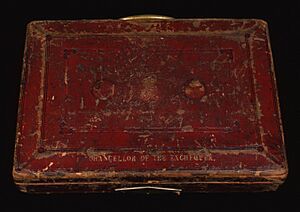

The National Archives is the official archive for His Majesty's Government. It holds 1,000 years of history. This includes everything from the Domesday Book to modern digital files and archived websites.
Here are some types of materials you can find at Kew:
- Documents from old courts of law, going back to the 1100s.
- Records from the central government from medieval times to today.
- A huge collection of maps, plans, and building drawings.
- Records for people researching their family history. This includes wills and criminal records.
- Records from the armed forces, like the War Office and Admiralty.
- Letters and files from the Foreign Office and Colonial Office.
- Cabinet papers and Home Office records.
- Statistics from the Board of Trade.
- Records from English railway companies.
TNA also has a museum. Here, you can see famous documents like the Domesday Book. The museum also has exhibitions using items from its collections.
Amazing Highlights of the Collection
The National Archives holds many incredible historical items. Here are just a few:
- The Domesday Book, a unique record of medieval England from 1086.
- A final version of the Magna Carta, issued by King Henry III in 1225.
- The chest containing the Treaty of Brétigny from 1360. This treaty ended the first part of the Hundred Years' War.
- A copy of the first item printed in England by William Caxton in 1476.
- A gold seal from Francis I from a peace treaty between France and England in 1527.
- A letter from Sir Francis Drake during the Spanish Armada in 1588.
- The signed confession of Guy Fawkes from the Gunpowder Plot in 1605.
- The last will of William Shakespeare with his signature from 1616.
- The record of Charles I's trial for treason from 1649.
- An indictment letter for the famous highwayman Dick Turpin from 1739.
- A letter from Captain Cook before his first voyage in 1768.
- The Olive Branch Petition from 1775, which tried to stop war between the American colonies and Great Britain.
- Three copies of the first printed record of the US Declaration of Independence from 1776.
- The logbook of William Bligh from HMS Bounty from 1789, describing the famous mutiny.
- The last will of the famous author Jane Austen from 1817.
- A copy of the Treaty of Nanjing from 1842.
- A calling card left by the Marquis of Queensberry for Oscar Wilde in 1895. This led to Wilde's trial.
- An SOS telegram from the Titanic in 1912.
- A copy of the Proclamation of the Irish Republic from 1916.
- A copy of the Treaty of Versailles from 1919.
- The signed letter of abdication by Edward VIII from 1936.
How to Access Documents
You can search for documents using Discovery. This is TNA's online catalog. It lists all the items they hold.
It's free to enter The National Archives building. You can use computers there or connect to their Wi-Fi with your own device. There are also reading rooms for looking at documents. To use these rooms, you need a free reader's ticket. Anyone aged 16 or older can get one. You just need two forms of ID.
Once you have a ticket, you can order documents. They usually arrive within 45 minutes if they are at Kew. Some documents are stored in a salt mine and take a few days to arrive.
Many popular documents have been digitized. You can download these from Discovery for a small fee. Since April 2020, registered users can get a certain number of free downloads each month. Some documents are also available through other websites like Ancestry.com and Findmypast.
If a document is available online, TNA encourages you to use the digital copy. This helps protect the original document from damage.
British Army Records from 1914 to 1919
Many British Army service records from World War I were stored in a warehouse in London. Sadly, a fire during the Second World War destroyed most of them. The records that survived were often damaged by fire or water. These are sometimes called the "Burnt Documents." They were put on microfilm and then made into digital images. You can find these on the Ancestry website.
Some other service records from this time were kept elsewhere and were not damaged. These are called the "Unburnt records." They are also available digitally on Ancestry.
British Army Records from 1920 to 1963
The Ministry of Defence started moving 9.7 million military records to The National Archives in February 2021. These records are for people who left the military before December 31, 1963. This was the largest transfer of records in TNA's history. The first records became available in April 2022. You can look at these records in person at TNA. You need to order them a few days in advance.
In March 2023, Ancestry announced they would digitize over 3 million more British Army service records. These will be released between 2024 and 2029.
How Documents Are Stored
Documents are kept on special shelves that can be moved. These shelves are pushed together to save space. When someone needs a document, the shelves can be moved apart to create an aisle.
The documents are usually stored in special acid-free folders or boxes. This helps protect them from damage. If there's a fire, TNA cannot use water sprinklers because it would ruin the documents. Instead, they release a special gas called argon into the storage rooms. This gas removes the oxygen and puts out the fire safely.
Other Services from The National Archives
TNA offers other services to help people with their research. It also helps you find collections that are not held at TNA itself.
Learning and Education
The National Archives has a free education website. It's great for teachers and students learning about history. You can choose different time periods, from medieval times to today. Each period has materials that teachers can use. Students can also find tips for research using historical documents.
"Access to Archives" (A2A)
Access to Archives (A2A) is a database. It has details about collections held in many different archives across England and Wales. While new collections are not being added, you can still use the existing information.
National Register of Archives (NRA)
The National Register of Archives (NRA) is a central place for information about historical documents related to British history. It includes over 44,000 lists and catalogs of collections. These are found in the UK and other countries. You can look at the register in TNA's reading room.
TNA collects this information in different ways. Other archives send their catalogs to TNA. TNA also surveys archives each year to find out about new items they have received.
ARCHON Directory
The ARCHON Directory is a database of contact details for archives in the UK. It also lists places around the world that have large collections of British history documents.
"Your Archives"
"Your Archives" was an online community where users could add information about historical records. It was closed in 2012. Now, users can add tags to items in the Discovery catalog. This helps people work together to improve the information.
Special Databases
The National Archives also hosts several databases for specific types of records. These include hospital records, migration records, and records about manors.
TNA worked with the Wellcome Library to create the Hospital Records Database. This database has not been updated since 2012. The Manorial Documents Register is still being updated.
Civil Pages
The National Archives runs the Civil Pages project. This is an online directory for the civil service. It helps government departments share knowledge and work together securely.
Smartphone Apps

In 2011, TNA released its first smartphone app called "Old Money." This app uses historical price data to show what old money would be worth today.
In September 2011, TNA's museum started using QRpedia codes. You can scan these codes with your phone to get information about exhibits from Wikipedia.
Blogs and Podcasts
TNA regularly posts blogs on its website. These blogs cover many topics, from historical events to features on documents in TNA. They also share information about how the archive works.
The "Archives Media Player" section has videos and podcasts created by TNA.
Lost and Misplaced Records
Sometimes, documents from the archives are reported missing. Between 2005 and 2011, over 1,500 files were reported missing. These included letters from Winston Churchill. However, about 800 of these records have been found. TNA believes most are just misplaced, not permanently lost. In 2017, about 1,000 files were removed by government officials and not returned. TNA says that the number of missing files is very small compared to the huge number of documents they hold.
MI5 Records at TNA
The National Archives receives records from MI5, which is the UK's security service. Some information or records might be kept secret by MI5.
MI5 Records in the News
MI5 records about former British Prime Minister Margaret Thatcher have caused some discussion. In 2017, a journalist said that MI5 was holding back information the public should know. This included Thatcher's concerns about British activities in Northern Ireland.
Other MI5 records showed that government workers were sometimes put on "blacklists" during Thatcher's time. These blacklists also included groups like unions and minorities. These records have led to questions about how transparent the government is. People also wonder if these blacklists affected people's careers. Questions remain about whether such blacklists still exist today.
See also
 In Spanish: Archivos Nacionales del Reino Unido para niños
In Spanish: Archivos Nacionales del Reino Unido para niños
- UK Government Web Archive
- International Standard Bibliographic Description
- List and Index Society
- List of national archives
- PRONOM technical registry


